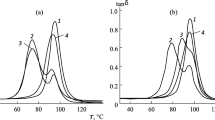Abstract
The effect of functionalized thin multiwall carbon nanotubes (f-MWCNTs, 2–6 graphene layers) on a rigid epoxy matrix is studied. As a result of f-MWCNT modification, the elastic modulus of the matrix is retained and the ultimate strain and, hence, the strength of the cross-linked polymers increase. According to X-ray diffraction and transmission electron microscopy data, the increase in the strength is related to the f-MWCNT-induced change in the structure of the epoxy matrix.
Similar content being viewed by others
References
P. M. Ajayan and J. M. Tour, “Material Science: Nanotube Composites,” Nature 447, 1066–1068 (2007).
E. Bekyarova, E. T. Thostenson, A. Yu, et al., “Multiscale Carbon Nanotube-Carbon Fiber Reinforcement for Advanced Epoxy Composites,” Langmuir 23, 3970–3974 (2007).
H. Chen, O. Jacobs, Wei Wu, et al., “Effect of Dispersion Method on Tribological Properties of Carbon Nanotube Reinforced Epoxy Resin Composites,” Polymer Testing 26(3), 351–360 (2007).
C.-H. Tseng, “Functionalizing Carbon Nanotubes by Plasma Modification for the Preparation of Covalent-Integrated Epoxy Composites,” Chem. Mat. 19, 308–315 (2007).
R. Zhu, E. Pan, and A. K. Roy, “Molecular Dynamics Study of the Stress-Strain Behavior of Carbon-Nanotube Reinforced Epon 862 Composites,” Mater. Sci. Eng. A 447, 51–57 (2007).
F. Du and K. I. Winey, “Nanotubes in Multifunctional Polymer Nanocomposites,” in Nanomaterials: Handbook, Ed. by Yu. Gogotsi (CRC Press, London, 2006), pp. 565–582.
M. J. Biercuk, M. C. Llaguno, M. Radosavljevic, et al., “Carbon Nanotube Composites for Thermal Management,” Appl. Phys. Lett. 80(15), 2767–2769 (2002).
B. Fiedler, M. Gojny, M. Wichmann, et al., “Fundamental Aspects of Nano-Reinforced Composites,” Compos. Sci. Techn. 66, 3115–3125 (2006).
E. T. Thosterson, Z. Ren, and T.-W. Chou, “Advances in the Science and Technology of Carbon Nanotubes and Their Composites: A Review,” Compos. Sci. Techn. 61, 1899–1912 (2001).
M. Moniruzzman, Du Fangming, N. Romero, and K. I. Winey, “Increased Flexural Modulus and Strength in SWNT/Epoxy Composites by a New Fabrication Method,” Polymer 47, 293–298 (2006).
Long Xie, Feng Xu, Feng Qiu, et al., “Single-Walled Carbon Nanotubes Functionalized with High Bonding Density of Polymer Layers and Enhanced Mechanical Properties of Composites,” Macromolecules 40(9), 3296–3305 (2007).
V. P. Grachev, R. V. Akatenkov, V. N. Aleksashin, et al., “Increasing the Properties of Epoxy Polymers by Small Additions of Functionalized Carbon Nanoparticles,” in Proceedings of I International Forum on Nanotechnologies Rusnanotech 08, Moscow, Russia (2008), pp. 410–412.
R. V. Akatenkov, S. M. Aldoshin, V. N. Aleksashin, et al., “Effect of Small Additions of Thin Multilayer Carbon Nanotubes on the Structure and Properties of Glassy Polymers,” Dokl. Akad. Nauk 437(5), 632–635 (2011).
R. V. Akatenkov and I. V. Anoshkin, “Criterion for the Efficiency of Using Functionalized Carbon Nanotubes to Improve the Physicomechanical Properties of Epoxy Resins,” in Proceedings of II International Forum on Nanotechnologies Rusnanotech 09, Moscow, Russia (2008), pp. 301–303.
G. V. Korolev, M. M. Mogilevich, and I. V. Golikov, Cross-Linked Polyacrylates. Microheterogeneous Structures, Physical Networks, and Deformation-Strength Properties (Khimiya, Moscow, 1995).
Yu. S. Lipatov, Interfacial Phenomena in Polymers (Naukova Dumka, Kiev, 1980).
J. Menson and L. Sperling, Polymer Mixtures and Composites (Khimiya, Moscow, 1979).
Author information
Authors and Affiliations
Corresponding author
Additional information
Original Russian Text © R.V. Akatenkov, V.N. Aleksashin, I.V. Anoshkin, A.N. Babin, V.A. Bogatov, V.P. Grachev, S.V. Kondrashov, V.T. Minakov, E.G. Rakov, 2011, published in Deformatsiya i Razrushenie Materialov, 2011, No. 11, pp. 35–39.
Rights and permissions
About this article
Cite this article
Akatenkov, R.V., Aleksashin, V.N., Anoshkin, I.V. et al. Effect of low contents of functionalized nanotubes on the physicomechanical properties and structure of epoxy compositions. Russ. Metall. 2013, 245–250 (2013). https://doi.org/10.1134/S0036029512100023
Received:
Published:
Issue Date:
DOI: https://doi.org/10.1134/S0036029512100023




